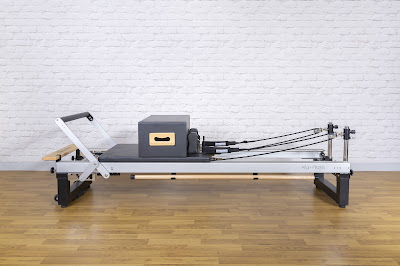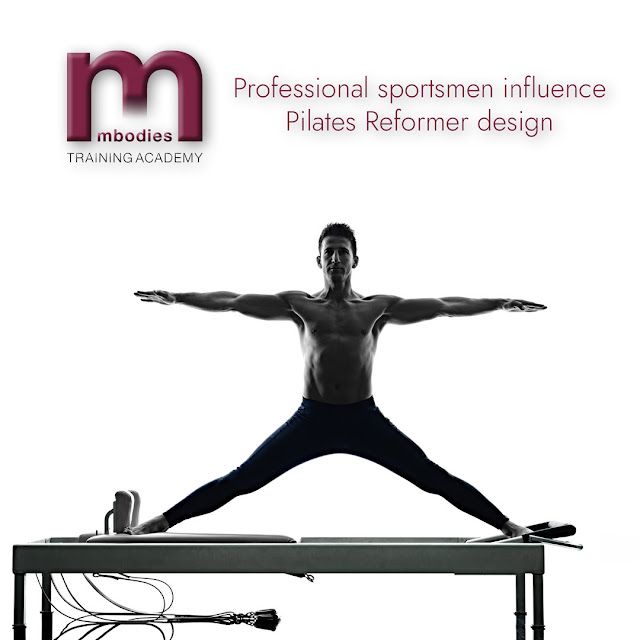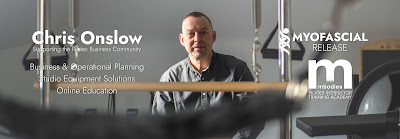Pilates Popularity with Professional Sportsmen influences Reformer Design
From the turn of the new millennium Pilates has increasingly featured in men’s
exercise and sports training regimes in the UK.
When practicing Pilates, the resultant enhanced strength, balance,
flexibility and control provide increased performance whilst offering reduced
chance of injuries. In particular the
use of a Pilates Reformer for sportsmen has grown because the multi directional
forces offered from springs, pulleys and cables can increase strength, control
and balance through incremental increases in resistance. Compared to Pilates Matwork using only
bodyweight and practiced on a fixed surface, the moving carriage on a reformer
will also force the user to exercise the correct or minor muscles that are
needed when their competitive sport requires an under-utilised muscle movement. This helps prevent injuries.
Equipment resistance may be adjusted according to the requirement to
increase strength and performance, or to proactively protect from injury by
moderating the exercise in case of weakness, injury or rehabilitation
These advantages of Pilates Apparatus Training are being exploited by professional
sportsmen, particularly in Rugby, Tennis, Cricket and Football. The physical size of many of the players in
these sports is often above that of the average man. Most Pilates equipment was originally designed
with women or male dancers in mind, therefore the new popularity in men’s
sport has highlighted some unsuitability in traditional design and hence, a
requirement for larger and stronger apparatus. As a result, some Pilates
Apparatus manufacturing companies have introduced equipment models to cater for
the larger physique and weight of these sportsmen.
The overall benefits of Pilates for Men
- Increased flexibility and range of motion – stretching out muscles and improving joint movement. Pilates' focus on flexibility and lengthening to increase your range of motion.
- Increased strength – Overall core strength and fitness are increased by precise, focused movements enhancing the musculature around the lower back, hips, pelvis, and abs. The muscles working in synergy spread the load, and otherwise neglected muscles are then highlighted for attention, supporting your larger muscles for stronger performance, with fewer injuries.
- Balancing the body: Pilates works both sides of the body equally, avoiding asymmetry by highlighting any imbalances and allowing you to concentrate on strengthening the weaker side.
- Prevention and recovery from injuries: The precision and control principles of Pilates allow your muscles greater stability and better form, enabling you to have more control over your movements preventing over-use. Since Pilates, and in particular, apparatus resistance can be tailored to any level and for any injury, it is excellent for physiotherapy.
- Reduces back pain: Pilates has proven to be highly effective for alleviating lower back pain safely.
- Better breathing: Pilates focuses on diaphragmic breathing, oxygenating your muscles so that they can perform better. The concentration on correct breathing also has great benefits to mental health, both reducing stress, and increasing mental clarity.
Specific benefits for Men's Sports
 |
| Pilates in Cricket |
Cricketers Using Pilates
- In mid-2005 Paul Collingwood, needed to have a custom-made Pilates Reformer manufactured specially with a longer carriage. This was one of the first instances highlighting a design shortcoming of reformers for larger men in sport.
- The Australian fast-bowling attack uses Pilates to strengthen the area between the hip and shoulders, as part of injury prevention conditioning.
- Mike Atherton, the former England captain, was one of the first to use Pilates as a way both to prevent and recover from injuries.
- Andrew Flintoff (Fast Bowler) adopted Pilates to help with back issues.
- Graham Thorpe, England batsman, has also used Pilates for back issues.
Pilates is practiced in these Football clubs:
Arsenal FC, Reading FC, Derby County, Manchester City Goalies, Aston Villa
Goalies, Chelsea FC
Manufacturers design appropriate Reformer models for men in sport
 |
| Align Pilates A8 Pro |
Align Pilates has Introduced its A8-Pro Reformer suitable for the
taller, wider, and heavier sportsman.
257cm long, 75cm wide, £2,400
For more information visit Align Pilates
 |
| Balanced Body Allegro Stretch |
Balanced Body has designed its stretch reformer model for tall users.
Allegro® Stretch Reformer Perfect for users over 6’4″ (195cm)
282cm Long, 62cm Wide, £3,750
For more information visit Balanced Body
 |
| Basi Systems Standard Reformer |
BASI Systems have made their standard reformer with both longer
travel and a wider bed.
234cm Long, 72cm Wide, £4,700
For more information visit BASI systems
Author: Adrian Baughan - Digital content and marketing for Mbodies Training Academy
For information about Mbodies Training Academy visit: https://www.mbodiesacademy.com/
For Online Pilates Teacher Training visit: https://mbodies.thinkific.com/
Chris Onslow - Pilates Consultant
Chris Onslow, has run Pilates focussed businesses since 1998. He and his team specialise in supporting Pilates entrepreneurs and business owners. With a rich history of owning and running successful Pilates studios in the UK, and supporting others in Europe and the Middle East, Chris has broad expertise in maximising profitability and optimising operational efficiency. His agency provides top-tier advice on selecting new, pre-owned, and hireable Pilates equipment from renowned brands such as Align-Pilates, Balanced Body or Stott-Pilates/Merrithew. As the founder of Mbodies Training Academy, Chris continues to revolutionise Pilates education, offering premier online and hybrid CPD and qualification courses for Pilates apparatus instruction and special population CPD. Discover more about how Chris can support your Pilates Business or home exercise choices at www.pilates-consultant.co.uk










Comments
Post a Comment